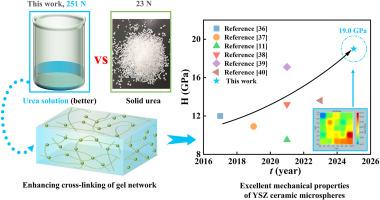Enhanced mechanical properties of YSZ ceramic microspheres via urea solution-modified external gelation process
IF 5.6
2区 材料科学
Q1 MATERIALS SCIENCE, CERAMICS
引用次数: 0
Abstract
Yttria-stabilized zirconia (YSZ) ceramic microspheres are widely used in catalysts, biomaterials, and nuclear applications. However, their preparation faces challenges such as localized precipitation and complex additive compositions. This study proposes a simplified external gelation process using urea solution to replace solid urea, addressing these issues. The effects of urea content and zirconium sources (ZrOCl2 vs. ZrO(NO3)2) on colloidal particle size, broth pH, and mechanical properties were systematically investigated. Electron cloud density maps of colloid particles were resolved using small-angle X-ray scattering and the Denss database. Compared to solid urea, the urea solution prolonged hydrolysis, enabling uniform pH adjustment and rapid sol-to-gel transition. The optimal formulation (ZrOCl2 with n(urea/Zr) = 6:1) prepared crack-free YSZ ceramic microspheres with near-perfect sphericity (1.01 ± 0.01), an exceptional average hardness (19.0 GPa), and an average crushing strength of 251 N-11 times higher than the microspheres prepared by solid urea (23 N). The urea solution-modified external gelation process achieves an 11 % hardness increase over prior studies and a 73 % crushing strength improvement over commercial YSZ ceramic microspheres, offering a scalable approach for enhancing mechanical properties of YSZ ceramic microspheres.

尿素溶液修饰外凝胶法制备YSZ陶瓷微球,提高其力学性能
氧化钇稳定氧化锆(YSZ)陶瓷微球广泛应用于催化剂、生物材料和核领域。然而,它们的制备面临着诸如局部沉淀和复杂的添加剂组成等挑战。本研究提出了一种简化的外凝胶工艺,使用尿素溶液代替固体尿素,解决了这些问题。系统研究了尿素含量和锆源(ZrOCl2 vs. ZrO(NO3)2)对胶体粒径、肉汤pH和力学性能的影响。利用小角x射线散射和密斯数据库对胶体粒子的电子云密度图进行了解析。与固体尿素相比,尿素溶液延长了水解时间,实现了均匀的pH调节和快速的溶胶-凝胶过渡。最佳配方ZrOCl2 (n(尿素/Zr) = 6:1)制备的无裂纹YSZ陶瓷微球具有接近完美的球形度(1.01±0.01),优异的平均硬度(19.0 GPa),平均破碎强度比固体尿素(23 n)制备的微球高251 n -11倍。尿素溶液修饰的外部胶凝工艺使YSZ陶瓷微球的硬度比先前的研究提高了11%,粉碎强度比商用YSZ陶瓷微球提高了73%,为提高YSZ陶瓷微球的机械性能提供了一种可扩展的方法。
本文章由计算机程序翻译,如有差异,请以英文原文为准。
求助全文
约1分钟内获得全文
求助全文
来源期刊

Ceramics International
工程技术-材料科学:硅酸盐
CiteScore
9.40
自引率
15.40%
发文量
4558
审稿时长
25 days
期刊介绍:
Ceramics International covers the science of advanced ceramic materials. The journal encourages contributions that demonstrate how an understanding of the basic chemical and physical phenomena may direct materials design and stimulate ideas for new or improved processing techniques, in order to obtain materials with desired structural features and properties.
Ceramics International covers oxide and non-oxide ceramics, functional glasses, glass ceramics, amorphous inorganic non-metallic materials (and their combinations with metal and organic materials), in the form of particulates, dense or porous bodies, thin/thick films and laminated, graded and composite structures. Process related topics such as ceramic-ceramic joints or joining ceramics with dissimilar materials, as well as surface finishing and conditioning are also covered. Besides traditional processing techniques, manufacturing routes of interest include innovative procedures benefiting from externally applied stresses, electromagnetic fields and energetic beams, as well as top-down and self-assembly nanotechnology approaches. In addition, the journal welcomes submissions on bio-inspired and bio-enabled materials designs, experimentally validated multi scale modelling and simulation for materials design, and the use of the most advanced chemical and physical characterization techniques of structure, properties and behaviour.
Technologically relevant low-dimensional systems are a particular focus of Ceramics International. These include 0, 1 and 2-D nanomaterials (also covering CNTs, graphene and related materials, and diamond-like carbons), their nanocomposites, as well as nano-hybrids and hierarchical multifunctional nanostructures that might integrate molecular, biological and electronic components.
 求助内容:
求助内容: 应助结果提醒方式:
应助结果提醒方式:


